Location, Access, Structures, Utilities and Services

We have a lot of choices for vacation properties in British Columbia and each of us has different priorities: proximity to water, acreage (gardening?), shopping, services and recreation.
One priority that is extremely common is a reasonable travel time from the Lower Mainland. Go West and you’re taking a ferry. North means you have one option: the Sea to Sky highway, which really throws a wrench in your plans when it’s closed. Head East and you’ll find more options, and more winter-like conditions for part of the year. Going South means you’re taking on the border and added tax complications.
I’ll let you choose which direction makes the most sense for you. No matter which way you go, there are a few things I want to put on your radar if you’re looking at property outside of a fully serviced city grid. You’re going to want to wait for Part 2B if you plan to buy within a developed city with water and sewer at the property line. This post (Part 2A) touches on some of the unexpected quirks of rural property.
Accessing Vacation Property
This isn’t about paved roads, road closures, landslides or snow storms. This is about what happens when you get within a few kilometers of the property. Boat access only? Private road? Gravel road? Plowed, maintained, or not?
We take for granted the simplicity of accessing our homes on a small parcel of land. Buy an acre with the house 200m from the road and you’re 100% responsible for maintaining that 200m. It could wash out in heavy rain. You might need to clear snow in winter.
The longer that stretch of road gets, the more complicated it gets. Many acreages are accessed by public roads that are outside the boundary of regular maintenance, which includes snow removal. Residents on those stretches have to sort it out on their own. It’s even more complicated and costly if there is an elevation change. It gets slippery, muddy, icy, washed away! It’s not a reason to avoid these properties. It’s my warning to you that the more remote you get the more work it is just to roll into your driveway.
It’s pretty amazing when you’re there. An abundance of land and privacy. Opportunity to make use of the land in the best way that suits your family. You just have to get there.
Structures (Residences and Out Buildings)
A stunning log cabin isn’t in the cards for all of us. You’re going to encounter a wide variety of structures from practical modular homes, old cottages, and custom homes. Standard residences are straightforward, but far less common in rural areas. You’ll see a lot of interesting custom homes and even more modular homes. Modular homes (can be referred to as park-model homes, commonly encountered as single wide or double wide trailers) can be considered by a lender as a non-permanent structure. The trouble with that is it changes the category of the property and how a mortgage can be structured. Bare land mortgages are more complicated and more costly than a typical mortgage secured by a permanent residence.
The lender wants to see a permanent, habitable structure in order to offer a conventional mortgage. That means it needs a permanent foundation, heat, water and sewer (septic, or otherwise). My vacation property includes an old park-model home (single-wide). It’s permanently fixed in place, connected to the well water supply and a septic system. It operates as a permanent structure, but it was flagged as not meeting their standard and my minimum down payment requirement was bumped up to something higher than the norm. I think they asked for a 30% down payment. Every situation will be different.
All the other structures on the property (barns, sheds, decks, docks, etc.) are often built and maintained without permits. Rural property owners make-do with what they have and it means you can see some quirky structures. Do not trust any structure based on what you see in photos. That’s a good starting point but you need to see it in person if you intend on keeping and making use of any structure on the property.
Utilities and Services
You want heat, water in and a way to flush it out. Properties within a city will have electricity, gas, water and sewer connections at the lot line (if not already a developed lot). Many rural properties often have electricity, but some could be very far from the nearest connection. Far enough that it’s more economical to go with solar and gas generators.
Large parcels of land will likely have you looking at water from a well, river, or lake. It could be sourced from your property or not. Sometimes it’s from a community water source, for which you pay an annual fee for use and maintenance (including mechanical and testing). It’s certainly beneficial to see recent results of water tests, but testing isn’t that common with individual property owners so don’t expect it (community water sources have regular testing schedules). You wouldn’t be out of line to request the opportunity to get a water sample tested as a condition of your offer.
It’s very common for rural properties to use a septic system. Septic systems are simple, but can be costly if something goes wrong. It’s too much to speak about in detail. Septic systems are common. Learn about them. Ask your agent. Do your research on the system type, age and maintenance when you find the right property. My property is within a community grid of lots roughly 50’x120’. Every lot has a well at the front and septic field in the back. Standard septic systems require a minimum clearance of 100’ from the well.
A septic system can run quite smoothly if treated right, but they have capacity limitations and that can be really meaningful if you have plans to gather multiple families at your property. Make sure to chat with your agent to learn move about septic capacity and how to work with it.
Gas is not usually piped into rural communities. You would keep a large propane tank on your lot that would be refilled periodically. A property might use gas for the heat source. It can also used for the fridge, stove, dryer and more if electricity is scarce.
Summary
It’s really fun to browse listings of vacation properties. They can look beautiful and very appealing in photos. Keep in mind what it takes to arrive at your door and what systems are in place to allow you to easily and quickly get everything running on arrival so you can enjoy your time. Know what you’re buying and know that even though it looks like a house it might not operate anything like what you’re accustomed to in the city. Oh, the bonus of that is that property taxes are very low…because most of the cost and responsibility falls to you.





